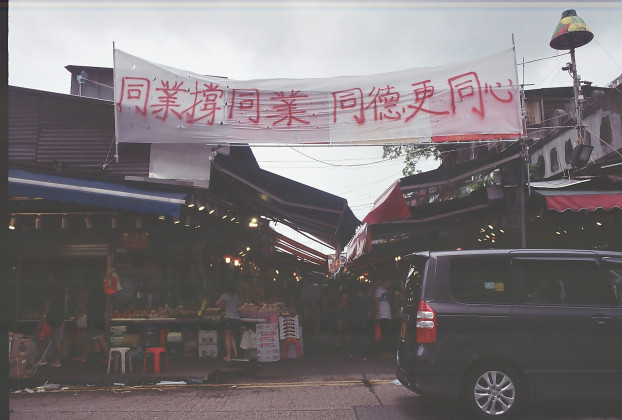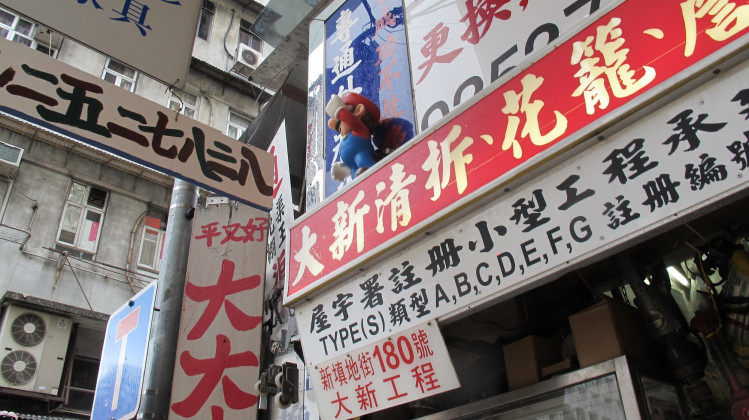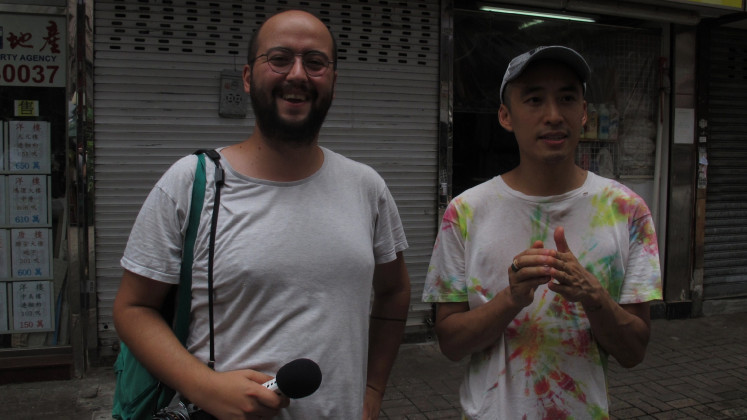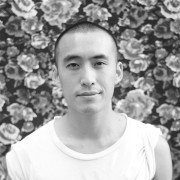Seeds of Awareness
Commoning Practices*, an interview series done by Yelta Köm and Elif Çak Köm, is documenting architecture and design collectives and their engagement methods with the community in Hong Kong. In the guidance of Michael Leung, this chapter looks into a collective movement that flourishes at a street stall in Yau Ma Tei neighborhood as a reaction to the current development plans.
“You guys are going to be forced to close in three months.”
Fruit market seller,** from the blog of 街坊排檔 (Kai Fong Pai Dong)
I was trained as an architect; that brings a lot of advantages, and disadvantages as well. Architecture has been changing in recent years: on one hand we had pioneers like Giancarlo Di Carlo, and all the other names; but on the other hand, we have this modernist history that creates the one man mythology. When I started this research, I began to ask these questions again—these questions that I’ve been wondering for a couple of years.
Frankly speaking, I do not have a proper answer either; and all the answers would be speculative, as well as provocative. Is it possible to collectively practice design and architecture? Can we understand the practice of design, the practice of architecture through our commons?
We are all sharing the same planet; we are all using its resources. We are changing; we are adding new epochs. But at the end of the day, they are all commons. How do we deal with our commons? Do we involve society in our practice? Or do we need to engage the society? What is the role of the architect and designer?
I am looking for these answers in daily practices, in collective groups, in activists. I also think designers and architects are part of the creating commons—some of them care, some of them do not even think about it.
Michael Leung is an urban farmer and a visiting lecturer, a designer in Hong Kong. I know his practice from the activities they are doing together with Pelin Tan about alternative urban pedagogies. He invited us to Prince Edward for an afternoon tea for our first meeting; we had a wonderful discussion. We walked around; we were getting to know each other. And the day after, we met again in front of the neighborhood street market stall in Yau Ma Tei, where, at the time, they were planting jackfruit seeds in pots.
Yelta Köm
Michael Leung: This is our new idea to raise awareness of what is happening in Wang Chau Village in Yuen Long. The government has proposed a development plan, and they are planning to evict and demolish the village in 2018. The village has many small farms and many jackfruit trees. We had a jackfruit festival a couple of weeks ago, and we felt that afterwards we could share the seeds of the jackfruit with other people. This is a way to meet new people and they could either support or share what is happening in Wang Chau. This shows a form of solidarity.
Yelta Köm: It reminds me a kind of offline network structure through the commons, which is also using the seed as a tool to increase awareness?
ML: Yes. A lot of people don’t know what is happening there because the media is very biased. This is an outreach program.
Elif Çak Köm: What are your expectations for people’s participation in this program? You will announce it in your stall, and you will give them the seeds, and they will start planting around the city?
ML: Right now we are just starting off the seedlings here. So we want to actually give them something rather than a seed, which needs a lot of care. When some seeds are ten or fifteen centimeters high, we will start an online campaign, which will be in collaboration with villagers who lead weekend village tours. So people will not only get a seedling, but they will also learn more about the village from a villager. And we are planning to start promotion through posters and stickers that we will put up in different places.
Additionally, we had a protagonist at the jackfruit festival, who was called Jackfruit Woman. She emerged from the movement, and these seeds are her future children. This is a story for children or people with a bit of an imagination.
We will also keep in touch with the people who grow these seedlings. Maybe we will create a group, and in the next five or ten years we will update each other on WhatsApp. Maybe in the future we will have another jackfruit festival and bring these people together again.
YK: As I understand it, you are also trying to keep a spirit of solidarity both in digital and physical ways. But for now I would like to focus on the physical ways. We are standing now in front of a green stall. Could you please explain the history of the stall? How did it start? What is its relationship with the city?
ML: It's history is not very long, only one year and seven months. But the history of the market stalls in Hong Kong goes back to the 40’s and 50’s, when people migrated from mainland China and during the Cultural Revolution, to start a new life in Hong Kong.
The government decided to create these small pieces of architecture, known as street market stalls. Most of them are green. And the reason for that color might be because green was a cheap paint color at the time. Or maybe it was painted green to enhance the freshness of the vegetables.
So, for example, this street used to be covered with these market stalls all the way to Nathan Road. But in the 1970’s the government decided to stop distributing licenses and that was essentially the start in decaying the street market culture. And the main reason behind it was that the government wanted to clean up the streets. These are informal spaces, and they become community hubs. The government wants to monitor and restrict people's activities in public spaces, and developers and shop owners want to speculate.
The government even offers an incentive for stall owners to give back their licenses. The incentive is 120,000 Hong Kong Dollars; which sounds like a lot, but in fact once you give it back, you lose your license, and the place becomes vacant.
The place will be used for informal car parking, but if you park here, you would get a parking ticket. The policy is unresolved. Is it a car park? Is it a shared place? Is it public space? We feel like it is a gray area. We had this opportunity to collaborate with the owner of the stall. We have been working here as a shared platform in a group, which is around twelve people. At the same time, however, it’s a platform for the community.
So some people will plant plants, vegetables and fruit trees here. A family will park their baby stroller here; some people will use the public furniture to sit and rest on. Some people will donate second-hand objects, preventing them from ending up in the landfill, and put them here under the canopy. We are very open. You can put up promotional materials here. The first three photos on the left are of a lady who is lives in an old people’s home, and she done some writing and drawings; and she asked for her photograph to be displayed.
It becomes a small exhibition space as well. We had one or two street exhibitions that we have promoted on Facebook. Members of the community often give us ideas, and we react to what is happening at the time, or what is given to us. Unintentionally, it became a second-hand shop because on the second day a neighbor decided to donate some clothes to us. We did not think of this stall as a second-hand shop but it just naturally happened.
YK: You transformed this simple component to a common space for the neighborhood, with a collective movement. Are you looking for any other ways to collaborate with the neighborhood? What kind of infrastructures do you use to support them?
ML: It's very organic and co-exists with the community–we have good relationships with different shops too. For example, the couple over there—they are the only market stall in this neighborhood that sells vegetables that are grown in Hong Kong. Sometimes it is not a collaboration, but we promote their stall, buy their produce, and we also give them some vegetables that we grow here.
And the launderette opposite us, we hang our keys there. We just put it here. They have become the guardian of our keys because we have twelve people and eight separate locks. The laundrette are open seven days a week, from eight AM to eight PM—long hours—twelve hours a day. So we asked if we could put them there, and they kindly agreed.
And then we find out more about them and some of their rental issues; so now we want to do something to support their business, because they support us.
YK: Do you think this common feeling is only in Yau Ma Tei, or all around Hong Kong? What would you also say for the other neighborhoods; do they have this kind of solidarity with each other?
ML: It’s not in every neighborhood. Only in old neighborhoods, like this one here.
YK: We are now in a neighborhood with craftsmen, small businesses; and actually it reminds me of Karaköy in Istanbul, where we have a similar structure. How are the relations between the Hong Kong-based designers and the architects?
ML: Here is a good place for making things, but unfortunately, I think a lot of designers in Hong Kong get things made in mainland China.
We are walking through the streets of humid Hong Kong, everywhere is so alive. It is crowded, every corner has a different story. I saw a building that was covered with bamboo scaffolding.
YK: What is this building? Is it a construction site? We saw a lot of shopping malls around here. Is it going to be another shopping mall?
ML: Probably, or maybe luxury apartments. The exterior is still there, but the interior is demolished. We used to have a rooftop farm there, and we got evicted by the developer. And now they are preparing to demolish the rest of the building.
YK: The value of the land is high here, right? The rents as well?
ML: Yes. It is uncontrollable. There used to be rent control, during British colonial times, but the government prefers to have this free market, which allows the landlords and developers to speculate as much as they want.
YK: It creates risks for the craftsmen and the small stores around here.
We continue our walk, Elif and I would like to take pictures of the market on the street. There was a handwritten banner at the entrance, in Chinese.
ML: Did you see this place before? This is the fruit wholesale market. It is over one hundred years old. Last year there was a fire, and 40 shops got burnt down inside. The government has refused to let them rebuild their shops, because they claim that they were squatters. They have been here for over 104 years. That is a very long squat.
YK: How do you squat for over 104 years? It is not a squat anymore! I would say.
ML: Now the fruit sellers have banners protesting against the government; which is sad, because many people come here for the architecture, the banyan trees, the atmosphere—the government should support this place but they refused to even let them renovate. The fire was on the left side. I heard yesterday that the government wants to build a park, which is their typical way of getting rid of any space that they don’t want. They turn it into a park, so everyone is happy.
YK: And then they are going to build something else probably, it is always the same pattern with decision makers.
We went to an old cafe to have a lunch. We continued the conversation there.
YK: How do you see the future of these kinds of practices like yours, in Hong Kong? Do you think there will be more of them?
ML: I hope so. Rent is crazy expensive in Hong Kong and rental contracts often last only two years. Even if future spaces last only two years, it’s still worth it. A lot can be done in two years.
But I think some people have to go through a process of decolonization, or reflect on their complicity in intentionally or unintentionally displacing communities. It’s natural for people to form roots in a neighborhood, but our upbringing can make us ignorant or blind to things that are naturally happening in a neighborhood. Things we may miss only after they are gone.
YK: It is true, we—as newcomers of the neighborhood—think that economic relationships will help us. We are also actors in the rising of rent, and we are part of the gentrification as well. But the important thing is to establish a dialogue with each other. Trying to involve them in processes does not help all the time—for example, we have that problem in some other neighborhoods.
ML: Our expenditure at the market stall is not so high, we rarely spend money! We don’t have pressures like the launderette, which has to be open for twelve hours a day. So we can be quite flexible. Some places have to be very hard working to survive. We have refused all interviews to date. We just don’t want to be part of that “acceleration,” whatever is happening right now. Someone from the government, or other people, might read an interview and misinterpret it, and then things get unnecessarily complicated? So we purposely don’t want to have interviews, we find ways of slowing down and focus on the present, with the neighbors. And of course, it's difficult, because someone could always say we are using the market stall for non-commercial purposes; that we are imposing our values and culture into the community. What if the community has never experienced free pricing, or a community garden like this? So we are also sharing our values in the neighborhood, but we are not forcing them on people. It is voluntary and open for discussion and debate.
YK: You are using the stall to facilitate the commons, which are there already. Maybe your approach is just highlighting them. You did not invent them; the community has them already. It is natural. Otherwise you cannot get this reaction.
ML: Yes. You are right—bartering existed since the dawn of humankind. Capitalism, greed and profit-over people has made us less aware of these relationships.
Some people were just saying that we are occupying public space and that we can’t be like this, or like that. Some people have been so affected by money and the existing system that they put up barriers–and develop a kind of isolation. We sometimes see it in some people who walk past. We would say hi and they would just ignore us and walk on. But over time, we have built up some strong relationships with some of our neighbors. Some of them cook lunch for us, and collect discarded useful objects for us to distribute at our stall.
YK: How do you position yourself as a designer and how do you see the future of the practice?
ML: The market stall encourages each one of us to think differently. It is like wearing different hats. As a designer at the market stall, you can also be a researcher or a photographer. But then the market stall gives you a completely different hat, and gloves! You then think differently. It's different to having a studio. You have a responsibility. How do we use this space? Is it too messy? Are there too many plants? Do we have spare time to open more often? So it takes us through this long journey, and we always question things. Should we do this? Should we do that? What films should we show? What happens if the police come? What do you say? Who does that planter belong to? And we always critique each other. A friend, who I run the market stall with, will say, “You are growing too many plants” and then I will tell him, “80% of these plants are grown by the neighbors.” Then he would tell me, “You cannot use the market stall like that because the government will be stricter on us, and other market stalls.” However, we can't stop neighbors from gardening because they have as much right to use the space as we do. They live there, and they live around the corner.
YK: I like one of the quotes from your blog, which states that this is not an art project.
ML: One of the market stall’s members said that. The Tumblr website is very progressive, and it inspires us along the journey. It makes it easy to archive what is happening at the market stall. The Facebook page is more casual and shares many links that we collectively come across. After big Tumblr updates, we will share the link on the Facebook page. The Facebook page is more like a stall front, easy to access with updates on our events, such as monthly screenings and storytelling nights with a group called Tales We Tell, who completely transform the street in front of the laundrette into an intimate space for listening and sharing our memories.
NOTES
*Commoning Practices is an interview series done by Yelta Kom and Elif Cak Kom with the support of Design Trust, Hong Kong. Commoning Practices is creating documentation of architectural and design collectives, and their engagement methods with the community in Hong Kong. This project aims to present a perspective on collective groups and their relations with common space, re-thinking the concept of commons and design within communities. The output will be a printed booklet and e-book, which will be combined with illustrations and graphic designs by Elif Cak Kom. This publication will offer a critical outline of current practices in the Hong Kong and projections about the future for collectives. This project seeks answers to following questions: Is it possible to practice design and architecture collectively? Can we understand the practice of design architecture through our commons? What is the role of design and architecture in the changing political and economic climate?
The name of the stall is "街坊排檔 Kai Fong Pai Dong”; it has a beautiful blog www.paidong.tumblr.com where you can find quotes, moments from the street, notes of meetings, and a livestream from the street.
Related Content:
-
Life as Commons
Stavros Stavrides demonstrates how the emergent practices of commoning are responding to coronavirus pandemic with collectivity, cooperation and solidarity.
-
Discovering the B-side of Architecture
Sebnem Soher talked with Sebastiao de Botton from Colectivo Warehouse on co-creating, self-critique and the afterlife of spaces.
-
Social Design for Beginners
Curated by Angeli Sachs, Social Design exhibition in the Museum for Gestaltung Zurich aims to discuss implications of growth economy on human beings, environment and design. Banu Çiçek Tülü reviewed the exhibition as a good example of inclusiveness in a country where democratic design processes emerge in urban scale.
-
Learning From Change
In conversation with Jan Boelen, the curator of 4th Istanbul Design Biennial on the theme of "A School of Schools." We discussed a variety of issues starting from the making of a design biennial up to design's capacity to respond to changes in the society.
-
New Forms of Conviviality
Hulya Ertas talked with Cristina Gamboa, one of the founder members of Lacol, on their approach as an architecture cooperative
-

Beyond Borders
-

A Play Experience
-

Collective Challenges
 28.03.2018
28.03.2018





















